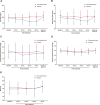Safety and efficacy of a novel dexmedetomidine nasal spray for pre-anesthetic sedation in children: a randomized, double-blind, placebo-controlled trial
- PMID: 39242499
- PMCID: PMC11378629
- DOI: 10.1186/s12871-024-02708-1
Safety and efficacy of a novel dexmedetomidine nasal spray for pre-anesthetic sedation in children: a randomized, double-blind, placebo-controlled trial
Abstract
Background: Off-label intranasal administration of injectable dexmedetomidine has been widely applied in the pediatric sedation setting. However, the development of an improved drug delivery system that is easy to use is needed. We developed a novel dexmedetomidine nasal spray that can be administered directly without dilution or configuration for pediatric pre-anesthetic sedation. This nasal spray has a fixed dose and is stable during storage. To the best of our knowledge, this is the first licensed nasal spray preparation of dexmedetomidine worldwide.
Objective: To evaluate the pre-anesthetic sedation efficacy and safety of the novel dexmedetomidine nasal spray in children.
Methods: The study was conducted at 11 sites in China between 24 November 2021 and 20 May 2022 and was registered in ClinicalTrials.gov (NCT05111431, first registration date: 20/10/2021). Subjects (n = 159) between 2 and 6 years old who were to undergo elective surgery were randomized to the dexmedetomidine group (n = 107) or the placebo group (n = 52) in a 2:1 ratio. The dosage was 30 µg or 50 µg based on the stratified body weight. The primary outcome measure was the proportion of subjects who achieved the desired child-parent separation and Ramsay scale ≥ 3 within 45 min of administration. Safety was monitored via the assessments of adverse events, blood pressure, heart rate, respiratory rate and blood oxygen saturation.
Results: The proportion of subjects achieving desired parental separation and Ramsay scale ≥ 3 within 45 min was significantly higher in the dexmedetomidine group (94.4%) vs the placebo group (32.0%) (P < 0.0001). As compared with placebo, dexmedetomidine treatment led to more subjects achieving Ramsay scale ≥ 3 or UMSS ≥ 2, and shorter time to reach desired parental separation, Ramsay scale ≥ 3 and UMSS ≥ 2 (all P < 0.0001). Adverse events were reported in 90.7% and 84.0% of subjects in the dexmedetomidine and placebo groups, respectively, and all the events were mild or moderate in severity.
Conclusions: This novel dexmedetomidine nasal spray presented effective pre-anesthetic sedation in children with a tolerable safety profile.
Keywords: Dexmedetomidine; Intranasal; Pediatric; Pre-anesthetic; Sedation.
© 2024. The Author(s).
Conflict of interest statement
This study was sponsored by Jiangsu Hengrui Pharmaceuticals Co., Ltd. Quanren Wang and Na Zhou are employees of Jiangsu Hengrui Pharmaceuticals Co., Ltd. No other authors declared potential competing interests.
Figures
References
-
- Kain ZN. Perioperative psychological trauma in children. 1st ed. W.B. Saunders: Philadelphia; 1990.
Publication types
MeSH terms
Substances
Associated data
LinkOut - more resources
Full Text Sources
Medical
Research Materials



